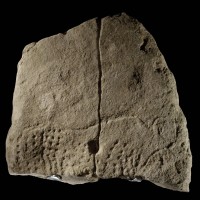An international team of anthropologists has unearthed a 38,000-year-old engraving of an aurochs at the Abri Blanchard site in Dordogne, southwestern France.
 First excavated in 1910, the Abri Blanchard rock shelter quickly proved itself to be an enormously rich source of archaeological material from the Aurignacian culture of the Upper Palaeolithic. It’s one of the top three Aurignacian sites in terms of numbers of bone pieces found, and archaeologists also found large quantities of flint tools, weapons and production waste indicating flint tools were being made inside the shelter. It wasn’t all business at Abri Blanchard, however. Decorative ornaments including soapstone beads, pierced shell and animal teeth were unearthed in the prehistoric deposits as were numerous artworks engraved and painted stone blocks and slabs.
First excavated in 1910, the Abri Blanchard rock shelter quickly proved itself to be an enormously rich source of archaeological material from the Aurignacian culture of the Upper Palaeolithic. It’s one of the top three Aurignacian sites in terms of numbers of bone pieces found, and archaeologists also found large quantities of flint tools, weapons and production waste indicating flint tools were being made inside the shelter. It wasn’t all business at Abri Blanchard, however. Decorative ornaments including soapstone beads, pierced shell and animal teeth were unearthed in the prehistoric deposits as were numerous artworks engraved and painted stone blocks and slabs.
As was accepted practice at the time, the finds from the 1910-1912 excavation of Abri Blanchard were sold in batches to collectors and museums and dispersed across Europe and the United States. The widespread selling artifacts was actually encouraged by the archaeological community because it was one of very few reliable sources of funding for future excavations, and it was inconceivable that all of materials recovered from such a rich dig could find a single home in a local or nationally prominent museum. The dig was also poorly documented, with no stratigraphic and spatial mapping, and while remains and objects were found in two archaeological layers, excavation director Louis Didon mingled the discoveries without concern for which layer they came from, grouping them by type or other shared criteria that appealed to buyers.
 In 2011, more than a century after the first excavations began, a new research team returned to Abri Blanchard to reexcavate the site armed with modern equipment and modern archaeological standards. In 2012, they unearthed a limestone slab engraved with the image of an aurochs (wild cow once native to Europe and one of my top three favorite extinct animals) decorated with dozens of dots aligned in neat rows.
In 2011, more than a century after the first excavations began, a new research team returned to Abri Blanchard to reexcavate the site armed with modern equipment and modern archaeological standards. In 2012, they unearthed a limestone slab engraved with the image of an aurochs (wild cow once native to Europe and one of my top three favorite extinct animals) decorated with dozens of dots aligned in neat rows.
The aurochs was a popular motif in Aurignacian art. The Abri Blanchard engraving has notable similarities in technique and design to the aurochs painted on the walls of the spectacular Chauvet Cave, and the aligned dots have been found in Chauvet as well as other Aurignacian sites in Germany and France.
“The discovery sheds new light on regional patterning of art and ornamentation across Europe at a time when the first modern humans to enter Europe dispersed westward and northward across the continent,” explains NYU anthropologist Randall White, who led the excavation in France’s Vézère Valley.
The findings, which appear in the journal Quaternary International, center on the early modern humans’ Aurignacian culture, which existed from approximately 43,000 to 33,000 years ago. […]
White contends that Aurignacian art offers a window into the lives and minds of its makers—and into the societies they created.
“Following their arrival from Africa, groups of modern humans settled into western and Central Europe, showing a broad commonality in graphic expression against which more regionalized characteristics stand out,” he explains. “This pattern fits well with social geography models that see art and personal ornamentation as markers of social identity at regional, group, and individual levels.”
Favorite extinct animals? 😮
Amazing to think of one culture surviving 10,000 years. Somehow our history looking backwards appears longer than the road infront! Fascinating.
To me, this looks like some form of ‘preliminary exercises’ in order to kill the ‘Big Black Bull’.
A couple of years ago, scientists from Cologne invited three gentlemen from the ‘San’ people in Namibia, in particular the experts Ui Kxunta, Ui Gao and Tsamkxao Ciqae (Cigae?), provided them with laser pointers, explained what caves, megafauna and ice age(s) are, and over two weeks they inspected ancient traces in several paleolithic caves in the French Pyrenees gaining new insights: youtu.be/cYT9-UrLcvA
As they put it in 1556: “Urus sum, polonis Tur, germanis Aurox: ignari Bisontis nomen dederant” – You made me moo! :hattip:
I :love: auroras too! The Taurus Project is working to bring those bad boys back.
Fie on spell check. Aurochs
If these folk engraved aurochs because they planned to eat them, why didn’t they also engrave Neanderthals?
My favourites are the auroral auroch authors 🙂
Amazing that they are still able to find new stuff from the aurignacions there! Early modern European Homo sapiens are my favourite not-so-extinct animal 😊